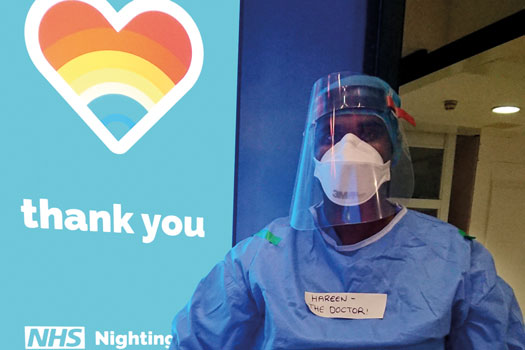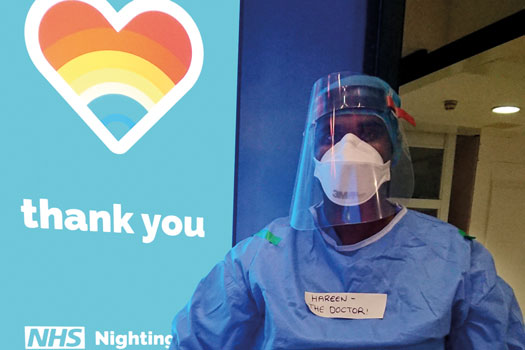
Profile – Dr Hareen De Silva
Location – London
Roles – Portfolio GP with an interest in expedition medicine and global health. Currently works for UKWHO, an organisation that promotes global health education.
Hours worked per week – 50 hours a week over two days and two night shifts
7.30am
I feel nervous arriving for my first shift. I was last on wards six years ago, but I did have six months of neonatal intensive care experience to fall back on.
7.45am
Changing into scrubs relaxes me, and I am given my patient allocations by the lovely volunteers as well as current updates to clinical practice.
This is the last time I’m able to go to the toilet for five hours until the first break. I’m partnered with a volunteer to help me in the ‘donning room’, and am given a label with my name and job role, and a green stripe that indicates I’m a junior ward doctor. I’m ready to enter the ward – an environment I know is full of infectious airborne particles.
8am
The first look at the ward and its vastness takes my breath away. This exhibition centre usually hosts yacht or car shows. Now, you look down a ward of 42 beds, 21 on each side, without curtains. Each bed has a computer, ventilator, obs machine, a dedicated clinical support worker and nurse, overseen by an ITU nurse.
A 50-metre river of NHS workers risking their own health to care for patients.
It really makes you grasp the enormity of the project. Also disorienting is the number of staff, all wearing visors, masks and full-length gowns. As am I.
We have a morning huddle where we confirm our bay allocations, which are six patients per junior doctor.
The induction day is a great learning opportunity to hear plans to wean people off ventilation and the nuances of lung physiology, which honestly have gone over my head at times. The reading list and e-learning modules help.
10am
The one thing that strikes me about Nightingale is the fighting spirit that everyone has.
The clinical team is made up of clinical support workers (dentists, HCAs, audiologists) who work on personal care, taking samples for testing and making sure observations are taken hourly. They are overseen by a critical care nurse, who alerts team members to important changes in a patient’s condition and offers guidance on assessing a deteriorating patient.
11am
There is a huddle with all the doctors to discuss clinical updates such as new drug charts or Nightingale policies, which is a useful time to connect with others.
12pm onwards
We decide among ourselves when we take breaks. We are allowed two breaks lasting an hour each and a comfort break of 15 minutes. The free hot meals served three times a day are a great morale booster. There is a different choice each day for breakfast, lunch and dinner.
Once your break is over, you’re back in the donning room with its jovial staff. You get to know them on a first-name basis as they make sure you are safe when you enter the ward.
8.30pm
By now my legs are aching and swollen because I’ve been on my feet so long, but the end is in sight. One thing I didn’t expect was that nights feel the same as days because we’re inside a giant windowless building with high-intensity lighting. Staffing levels are the same day and night, so those old feelings of dread when the night shift starts are not there.
The working pattern is two days, then two nights, then three days off. The only downside of the days off is that I am living in a hotel for eight weeks and have to entertain myself. Thankfully, the canteen is still accessible and there is a wellbeing centre where you can speak to someone if you need to.
Pulse July survey
Take our July 2025 survey to potentially win £1.000 worth of tokens












